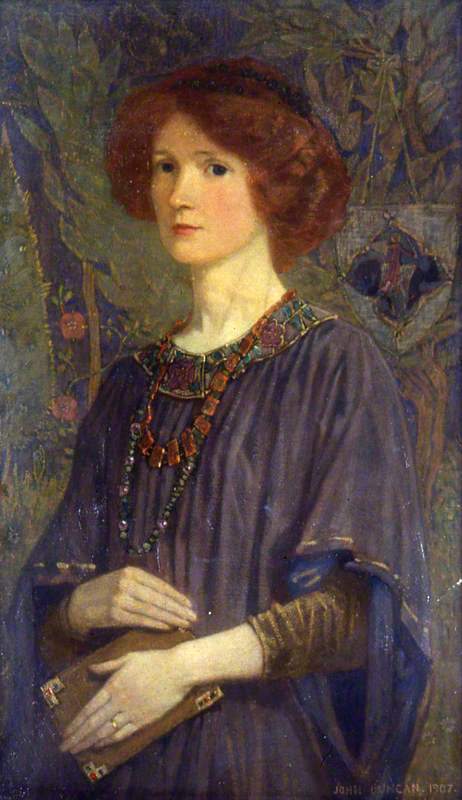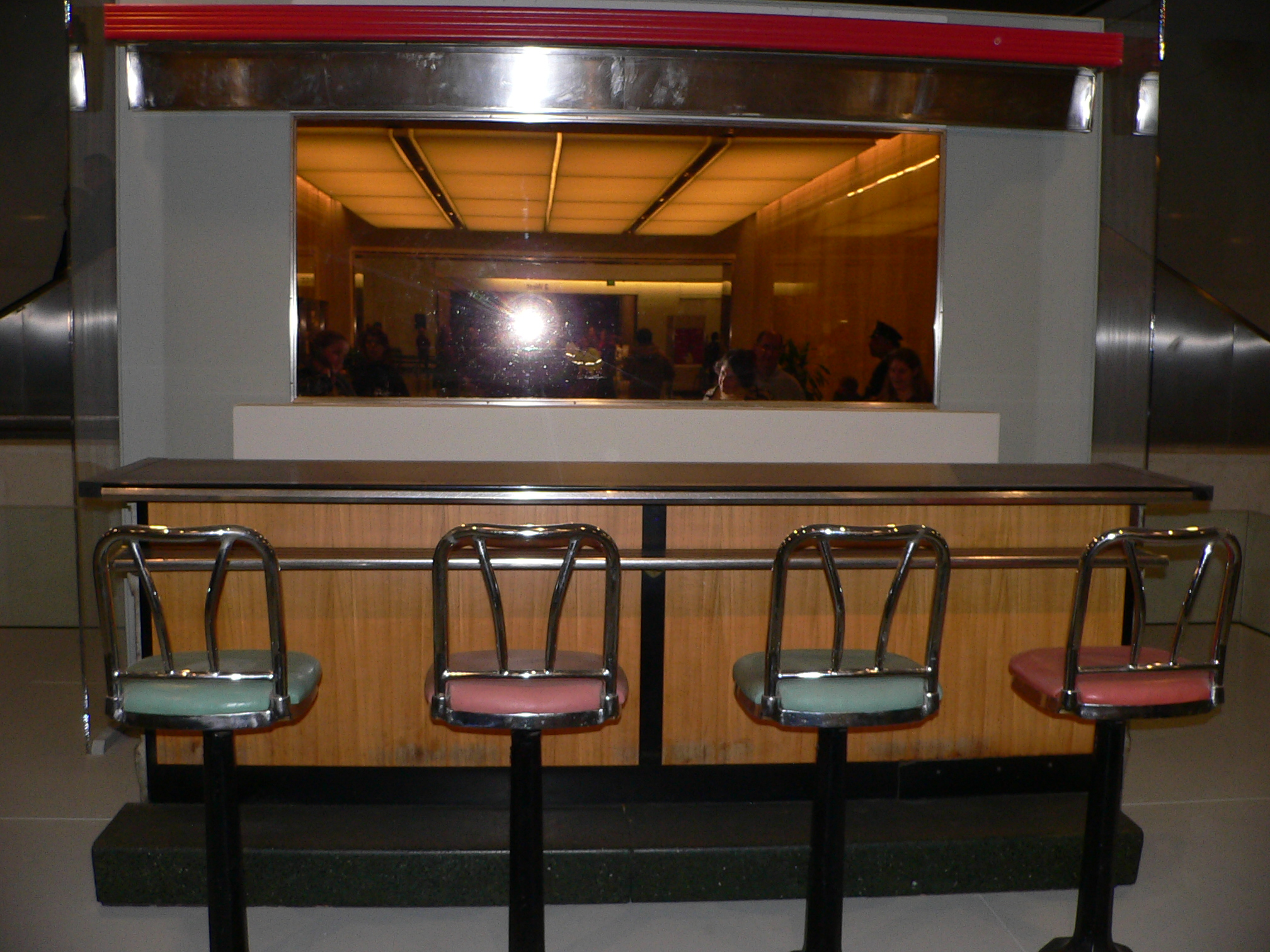|
Rachel Annand Taylor
Rachel Annand Taylor (3 April 1876 – 15 August 1960) was a Scottish poet, prominent in the Celtic Revival, and later a biographer and literary critic. Life and work Born in Aberdeen to stonemason John Annand and his wife Clarinda Dinnie, Rachel Annand was one of the first women to study at Aberdeen University, where her tutor was Herbert Grierson. Later she taught at Aberdeen High School for Girls on a site which is now Harlaw Academy and carries a yellow plaque commemorating her. Although she never took her degree, she was awarded an honorary LLD from Aberdeen University in 1943. Rachel Annand married Alexander C. Taylor in 1901 and lived in Dundee, mixing in Celtic Revival circles. In 1905 they were on the Hebridean island of Eriskay, to which she later devoted a poem. Also resident there at the time was John Duncan, who was to paint her portrait two years later. In this she is standing in front of a tapestry wearing a smock, beads and enamelled jewellery. In her hands is ... [...More Info...] [...Related Items...] OR: [Wikipedia] [Google] [Baidu] |
Richard Aldington
Richard Aldington (born Edward Godfree Aldington; 8 July 1892 – 27 July 1962) was an English writer and poet. He was an early associate of the Imagist movement. His 50-year writing career covered poetry, novels, criticism and biography. He edited '' The Egoist'', a literary journal, and wrote for ''The Times Literary Supplement'', '' Vogue'', '' The Criterion'', and ''Poetry''. His biography, ''Wellington'' (1946), won the James Tait Black Memorial Prize. Aldington was married to the poet Hilda Doolittle, known by her initials H.D., from 1913 to 1938. His acquaintances included writers T. S. Eliot, D. H. Lawrence, Ezra Pound, W. B. Yeats, Lawrence Durrell, C. P. Snow, and others. He championed H.D. as the major poetic voice of the Imagist movement and helped her work gain international notice. Early life and education Edward Godfree (known from an early age as "Richard") Aldington was born in Portsmouth, the eldest of four children of Albert Edward Aldington (1864–1921 ... [...More Info...] [...Related Items...] OR: [Wikipedia] [Google] [Baidu] |
1960 Deaths
It is also known as the "Year of Africa" because of major events—particularly the independence of seventeen African nations—that focused global attention on the continent and intensified feelings of Pan-Africanism. Events January * January 1 – Cameroon becomes independent from France. * January 9–January 11, 11 – Aswan Dam construction begins in Egypt. * January 10 – Prime Minister of the United Kingdom, British Prime Minister Harold Macmillan makes the Wind of Change (speech), "Wind of Change" speech for the first time, to little publicity, in Accra, Gold Coast (British colony), Gold Coast (modern-day Ghana). * January 19 – A revised version of the Treaty of Mutual Cooperation and Security between the United States and Japan ("U.S.-Japan Security Treaty" or "''Anpo (jōyaku)''"), which allows U.S. troops to be based on Japanese soil, is signed in Washington, D.C. by Prime Minister Nobusuke Kishi and President Dwight D. Eisenhower. The new treaty is opposed by t ... [...More Info...] [...Related Items...] OR: [Wikipedia] [Google] [Baidu] |
1876 Births
Events January * January 1 ** The Reichsbank opens in Berlin. ** The Bass Brewery Red Triangle becomes the world's first registered trademark symbol. *January 27 – The Northampton Bank robbery occurs in Massachusetts. February * February 2 ** The National League of Professional Base Ball Clubs is formed at a meeting in Chicago; it replaces the National Association of Professional Base Ball Players. Morgan Bulkeley of the Hartford Dark Blues is selected as the league's first president. ** Third Carlist War (Spain): Battle of Montejurra – The new commander General Fernando Primo de Rivera marches on the remaining Carlist stronghold at Estella, where he meets a force of about 1,600 men under General Carlos Calderón, at nearby Montejurra. After a courageous and costly defence, Calderón is forced to withdraw. * February 14 – Alexander Graham Bell applies for a U.S. patent for the telephone, as does Elisha Gray. * February 19 – Third Carlist War ... [...More Info...] [...Related Items...] OR: [Wikipedia] [Google] [Baidu] |
William Dunbar
William Dunbar (1459 or 1460 – by 1530) was a Scottish makar, or court poet, active in the late fifteenth and early sixteenth centuries. He was closely associated with the court of King James IV and produced a large body of work in Scots distinguished by its great variation in themes and literary styles. He was probably a native of East Lothian, as assumed from a satirical reference in '' The Flyting of Dumbar and Kennedie''. W. Mackay Mackenzie, ''The Poems of William Dunbar'', The Mercat Press, Edinburgh,1990. His surname is also spelt ''Dumbar''. Biography Dunbar first appears in the historical record in 1474 as a new student or ''determinant'' of the Faculty of Arts at the University of St Andrews.J.M. Anderson, ''Early records of the University of St Andrews: the graduation roll 1413–1579 and the matriculation roll 1473–1579'', Scottish History Society, Edinburgh, 1926A.I. Dunlop, Acta facultatis artium Universitatis Sanctandree, 1413–1588, Oliver and Boyd, Edinb ... [...More Info...] [...Related Items...] OR: [Wikipedia] [Google] [Baidu] |
Renaissance
The Renaissance ( , ) is a Periodization, period of history and a European cultural movement covering the 15th and 16th centuries. It marked the transition from the Middle Ages to modernity and was characterized by an effort to revive and surpass the ideas and achievements of classical antiquity. Associated with great social change in most fields and disciplines, including Renaissance art, art, Renaissance architecture, architecture, politics, Renaissance literature, literature, Renaissance exploration, exploration and Science in the Renaissance, science, the Renaissance was first centered in the Republic of Florence, then spread to the Italian Renaissance, rest of Italy and later throughout Europe. The term ''rinascita'' ("rebirth") first appeared in ''Lives of the Artists'' () by Giorgio Vasari, while the corresponding French word was adopted into English as the term for this period during the 1830s. The Renaissance's intellectual basis was founded in its version of Renaiss ... [...More Info...] [...Related Items...] OR: [Wikipedia] [Google] [Baidu] |
Metaphysical Poets
The term Metaphysical poets was coined by the critic Samuel Johnson to describe a loose group of 17th-century English poets whose work was characterised by the inventive use of conceits, and by a greater emphasis on the spoken rather than lyrical quality of their verse. These poets were not formally affiliated and few were highly regarded until 20th century attention established their importance. Given the lack of coherence as a movement, and the diversity of style among poets, it has been suggested that calling them Baroque poets after their era might be more useful. Once the Metaphysical style was established, however, it was occasionally adopted by other and especially younger poets to fit appropriate circumstances. Origin of the name In the chapter on Abraham Cowley in his '' Lives of the Most Eminent English Poets'' (1779–81), Samuel Johnson refers to the beginning of the 17th century in which there "appeared a race of writers that may be termed the metaphysical poets". T ... [...More Info...] [...Related Items...] OR: [Wikipedia] [Google] [Baidu] |
Scottish Renaissance
The Scottish Renaissance (; ) was a mainly literary movement of the early to mid-20th century that can be seen as the Scottish version of modernism. It is sometimes referred to as the Scottish literary renaissance, although its influence went beyond literature into music, visual arts, and politics (among other fields). The writers and artists of the Scottish Renaissance displayed a profound interest in both modern philosophy and technology, as well as incorporating folk influences, and a strong concern for the fate of Scotland's declining languages. It has been seen as a parallel to other movements elsewhere, including the Irish Literary Revival, the Harlem Renaissance (in the USA), the Bengal Renaissance (in Kolkata, India) and the Jindyworobak Movement (in Australia), which emphasised indigenous folk traditions. Beginnings The term "Scottish Renaissance" was brought into critical prominence by the French Languedoc poet and scholar Denis Saurat in his article "", which wa ... [...More Info...] [...Related Items...] OR: [Wikipedia] [Google] [Baidu] |
Hugh MacDiarmid
Christopher Murray Grieve (11 August 1892 – 9 September 1978), best known by his pen name Hugh MacDiarmid ( , ), was a Scottish poet, journalist, essayist and political figure. He is considered one of the principal forces behind the Scottish Renaissance and has had a lasting impact on Scottish culture and politics. He was a founding member of the National Party of Scotland in 1928 but left in 1933 due to his Marxist–Leninist views. He joined the Communist Party of Great Britain the following year only to be expelled in 1938 for his nationalist sympathies. He would subsequently stand as a parliamentary candidate for both the Scottish National Party (1945) and Communist Party of Great Britain (1964). Grieve's earliest work, including ''Annals of the Five Senses'', was written in English, but he is best known for his use of " synthetic Scots", a literary version of the Scots language that he himself developed. From the early 1930s onwards MacDiarmid made greater use of Engli ... [...More Info...] [...Related Items...] OR: [Wikipedia] [Google] [Baidu] |
Dante Gabriel Rossetti
Gabriel Charles Dante Rossetti (12 May 1828 – 9 April 1882), generally known as Dante Gabriel Rossetti ( ; ), was an English poet, illustrator, painter, translator, and member of the Rossetti family. He founded the Pre-Raphaelite Brotherhood in 1848 with William Holman Hunt and John Everett Millais. Rossetti inspired the next generation of artists and writers, William Morris and Edward Burne-Jones in particular. His work also influenced the European Symbolism (movement), Symbolists and was a major precursor of the Aesthetic movement. Rossetti's art was characterised by its sensuality and its medieval revivalism. His early poetry was influenced by John Keats and William Blake. His later poetry was characterised by the complex interlinking of thought and feeling, especially in his sonnet sequence ''The House of Life''. Poetry and image are closely entwined in Rossetti's work. He frequently wrote sonnets to accompany his pictures, spanning from ''The Girlhood of Mary Virgin' ... [...More Info...] [...Related Items...] OR: [Wikipedia] [Google] [Baidu] |
Stephen Banfield
Stephen David Banfield (born 1951) is a musicologist, music historian and retired academic. He was Elgar Professor of Music at the University of Birmingham from 1992 to 2003, and then Stanley Hugh Badock Professor of Music at the University of Bristol from 2003 to his retirement at the end of 2012; he has since been an emeritus professor at Bristol."Professor Stephen Banfield" ''University of Bristol''. Retrieved 18 December 2018.''International Who's Who in Classical Music 2009'' (, 2009), p. 49. Biography Banfield was educated at |
Edmund Rubbra
Edmund Rubbra (; 23 May 190114 February 1986) was a British composer. He composed both instrumental and vocal works for soloists, chamber groups and full choruses and orchestras. He was greatly esteemed by fellow musicians and was at the peak of his fame in the mid-20th century. The best known of his pieces are his eleven symphonies. Although he was active at a time when many people wrote twelve-tone music, he decided not to write in this idiom; instead, he devised his own distinctive style. His later works were not as popular with the concert-going public as his previous ones had been, although he never lost the respect of his colleagues. Therefore, his output as a whole is less celebrated today than would have been expected from its early popularity. He was the brother of the engineer Arthur Rubbra. Early life He was born Charles Edmund Rubbra at 21 Arnold Road, Semilong, Northampton. His parents encouraged him in his music, but they were not professional musicians, though h ... [...More Info...] [...Related Items...] OR: [Wikipedia] [Google] [Baidu] |







